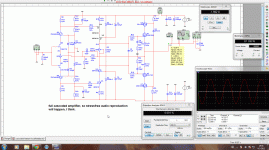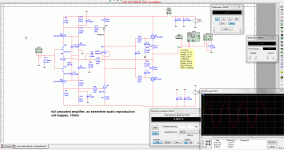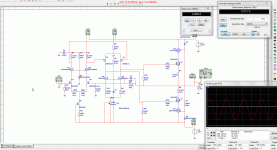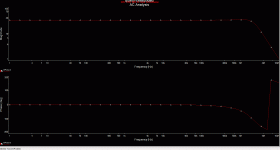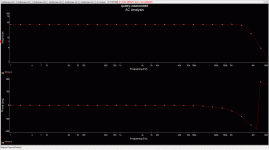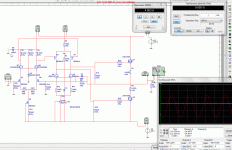Does anyone know anything about this amplifier? I would love to have some info about it, especially a schematic! Anyone heard it? Listening impressions?
The article is everywhere. Check PassLabs.com, PassDIY.com, FirstWatt.com, ...
Are you looking for information that is not in the article?
Are you looking for information that is not in the article?
Rsdio,
The cascode article shows a simplified schematic. I want to see the full version, if possible. I am talking about the one that Nelson mentions has been patented. It has a cascaded input, vas and output stage, but the schematic is diagrammatic and does not show the cascode voltages or biasing arrangements.
Buzzforb, the a40 is not a cascode amplifier as far as I can tell.
Any ideas anyone?
The cascode article shows a simplified schematic. I want to see the full version, if possible. I am talking about the one that Nelson mentions has been patented. It has a cascaded input, vas and output stage, but the schematic is diagrammatic and does not show the cascode voltages or biasing arrangements.
Buzzforb, the a40 is not a cascode amplifier as far as I can tell.
Any ideas anyone?
Hi,
These are af few schematics posted in the adress below:
http://www.diyaudio.com/forums/pass-labs/160310-threshold-cas-2-poweramp.html
I'd also be interested replacement parts for the transistors used. I've got a case, trannie and some capacitance ready...
regards,
Joris
These are af few schematics posted in the adress below:
http://www.diyaudio.com/forums/pass-labs/160310-threshold-cas-2-poweramp.html
I'd also be interested replacement parts for the transistors used. I've got a case, trannie and some capacitance ready...
regards,
Joris
Have you grabbed the patent documents?The cascode article shows a simplified schematic. I want to see the full version, if possible. I am talking about the one that Nelson mentions has been patented. It has a cascaded input, vas and output stage, but the schematic is diagrammatic and does not show the cascode voltages or biasing arrangements.
Hi,
These are af few schematics posted in the adress below:
http://www.diyaudio.com/forums/pass-labs/160310-threshold-cas-2-poweramp.html
I'd also be interested replacement parts for the transistors used. I've got a case, trannie and some capacitance ready...
regards,
Joris
Thanks Jazz, this is what I have been looking for!
Have you grabbed the patent documents?
There is no patent of mine referencing the circuit.
It's just the usual ways of cascoding circuits, at this time nothing you
haven't seen before.
😎
Hi,I'd also be interested replacement parts for the transistors used.
The outputs were 2n5878 and 2n5876, the inputs were 2n6571 and the
rest of the to92 were MPSL01 and MPSL51 if I recall correctly.
😎
Nice circuit kees. Very good simulated performance.
Have you ever simulated the circuit without cascodes? How did the performance compare? Just curious.
Also, in your circuit I note that Vds of the output devices will change with the output signal. Is this what we actually want for a cascoded stage? I'm keen to hear your insight as I have never managed to get an amplifier to simulate better with cascodes at audio frequences, however I have never used more than +/- 35v rails.
Greg.
Have you ever simulated the circuit without cascodes? How did the performance compare? Just curious.
Also, in your circuit I note that Vds of the output devices will change with the output signal. Is this what we actually want for a cascoded stage? I'm keen to hear your insight as I have never managed to get an amplifier to simulate better with cascodes at audio frequences, however I have never used more than +/- 35v rails.
Greg.
Nice circuit kees. Very good simulated performance.
Have you ever simulated the circuit without cascodes? How did the performance compare? Just curious.
Also, in your circuit I note that Vds of the output devices will change with the output signal. Is this what we actually want for a cascoded stage? I'm keen to hear your insight as I have never managed to get an amplifier to simulate better with cascodes at audio frequences, however I have never used more than +/- 35v rails.
Greg.
I have change the schematic two ways and did simulation, the vds did not change by the way, it was max 0.5 volts full power,
distortion is higher if I remove the driver cascode, if I remove only the output cascode then distortion is the same.
I had this idea from a bjt schematic, cascodes has, as the author say a high quality music reproduction, removing the cascode of the vas
is not a good idea even if simulation is good, cascodes are used to remove compression and give music a kind of freedom.
regards
Attachments
Last edited:
Thanks Kees. Very interesting. I'm going to have to have to reinvestigate this style of topology and play around with the simulator some more. I'd like to make a version with a single ended input and VAS. Going to add this circuit to my "to do" list.
Greg.
Greg.
I did quick made a single ended input, diff vas, with powercascode, I did see that for mosfets it is properbly not needed because simulation give no further details, what it do with music reproduction that afcourse I don,t now, goal of me was a amp without compression effects this is possible with cascodes, the diff vas is here for a quasy with two N fets.
on pictures you see high bandwith, distortion is higher with cascode power.
on pictures you see high bandwith, distortion is higher with cascode power.
Attachments
Last edited:
Thanks Kees, I just reread post 18 and post 15, and I see that your results are similar to mine. I have been unable to get a cascoded mosfet output stage to simulate any better than a non cascoded one, all other things being equal. Of course I am a novice with spice and this may not reflect how the circuit operates or sounds in real life.
I have also not tried a cascoded output stage using different devices for the main and cascode transistor. One could conceivably cascode a small fet like a irf610 with something larger like a irfp240 and enjoy the benefits of not having to drive such a large gate capacitance.
Cascoded VAS stages are a well known and proven entity however.
I have also not tried a cascoded output stage using different devices for the main and cascode transistor. One could conceivably cascode a small fet like a irf610 with something larger like a irfp240 and enjoy the benefits of not having to drive such a large gate capacitance.
Cascoded VAS stages are a well known and proven entity however.
special for mosfets we need voltage amplification and capacitance drive, the fact that cascode mosfet output power has no benefits because of the already high inpedance of the gate, cascode a BJT power output who has driven with current and low capacitance can have benefit of cascode. as you did see, the simulation are indeed not better with cascodes, i can try a bjt version.
- Status
- Not open for further replies.
- Home
- Amplifiers
- Pass Labs
- Pass bjt cascode amplifier from the 70s or 80s..
